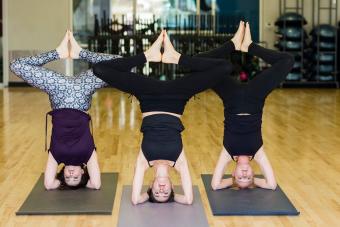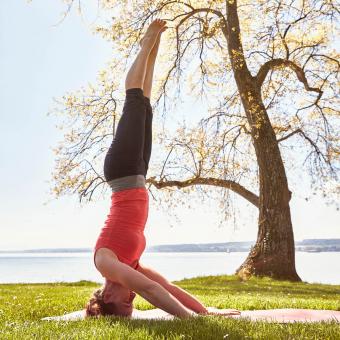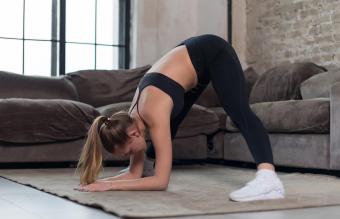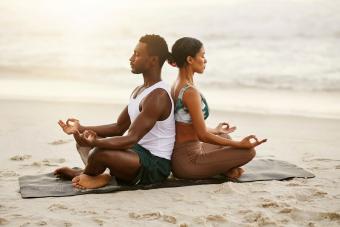
Enhance your yoga practice with advanced yoga inversions that require strength, stability, and proper alignment. If you're confident about your abilities and have been practicing yoga for some time, this is a good opportunity to take it up a notch. Make sure you have properly warmed up before trying these poses.
Handstands Are Advanced Inversions
The handstand is an arm balance and one of the first advanced inversions that most yogis try. There are three common ways to get into it.
- Hop from downward dog
- Single leg kick up
- Lift from wide-legged forward fold
They each require strength in the chest and shoulders as well as abdominal and inner thigh engagement. When you try it out for the first time, perform it against a wall or recruit a friend to catch your ankles and hold you upright. Once you are up in handstand, you can vary the pose by changing the position of your legs, either feet spread wide or in a split.

Supported Headstand
The headstand is a very challenging advanced pose that requires a great deal of strength in your neck and core. It also takes precision and balance. For both of these reasons, it's best to start off with the supported version. Once you've practiced that for a while, you can challenge yourself with a progression.
Progressions
If you feel stable in supported headstand, there are a couple of ways to make it more challenging.
- Vary the position of your feet - bring the bottoms of your feet together, taking your knees wide in a butterfly position or separate your feet wide for an upside down straddle position.

- Dial down the support - slide your arms out in front of you, palms facing the floor, or remove your hands entirely for the full expression of the pose.

The full expression of headstand places a lot of pressure on your neck, shoulders, and spine. For your safety, it's best to master it under the supervision of a yoga teacher before performing it on your own.
Forearm Stand
Because forearm stand requires a great deal of shoulder flexibility, it can be more challenging for those who are tight in this area. Try it against the wall to work your way up to the full expression of the pose.
- Begin in dolphin, facing the wall, hands about 12 to 24 inches away from the wall.
- Lift your right leg up behind you, making sure to keep your hips square and engage your inner thighs.
- Bend the knee of your supporting left leg and use it to hop up so that your right foot comes to the wall.
- Lift your left foot up to meet the right.
Once you feel confident enough against the wall, try moving further away from it to complete the pose without support. The next step will be extending to scorpion, which takes a bit more flexibility in your front body and strength in your back.
Wheel Pose From the Wall
Wheel Pose, also known as Upward Bow, is a deep back bend that requires strength in the glutes, shoulders and back, along with flexibility in the hip flexors and quadriceps. Most yoga instructors lead students into the pose from the ground up, which can be difficult for those who lack arm strength. If that's the case for you, try using the wall.
- Begin standing with your feet hip distance apart, facing away from the wall.
- Drawing your tummy in, extend your arms up above your head and slowly bend backward until you can place your hands flat against the wall.
- Slowly walk your hands down the wall until they reach the floor.
To come out, you can either walk your hands up the wall to go back the way you came or tuck your chin and slowly release to the floor.
Progressions
Whichever way you choose to get into wheel, once you feel comfortable with it, you can try more challenging versions of the pose.
- Single leg - simply lift one foot off the floor and point it straight up towards the ceiling.

- Forearms down - release your forearms to the floor for a deeper bend.

Each of these requires a bit more strength and flexibility.
Invert for Strength and Balance
Yoga inversions take practice to master. Trying the 4 poses listed here will not only help you gain strength and balance, but it will also give you the opportunity to release your fear in order to try something challenging and new. For best results, try a power yoga class or attend an inversion workshop, so that you can improve under the guidance of a skilled instructor.







